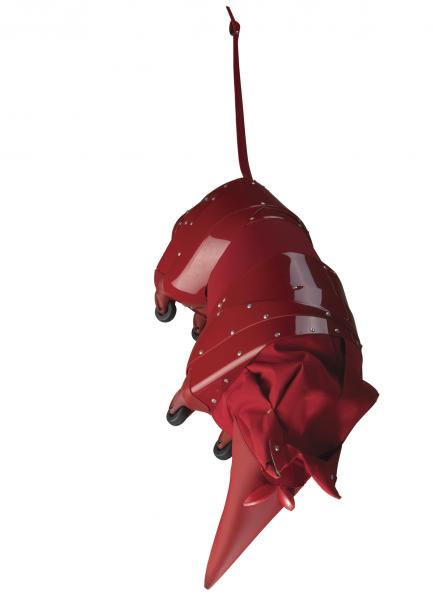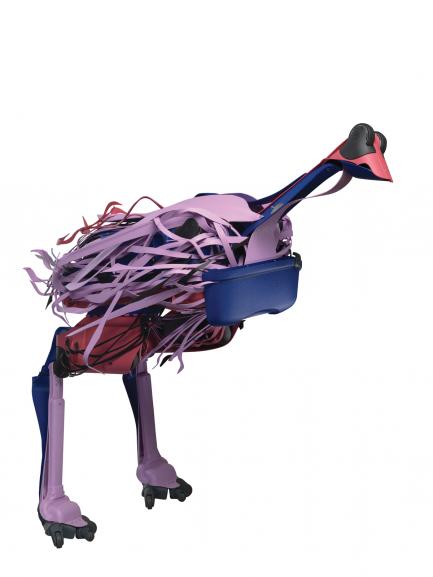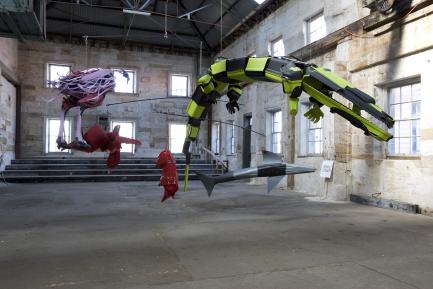Brian Jungen, Crux (as seen from those who sleep on the surface of the earth under the night sky) (detail), 2008. Suspended mobile depicting five animals. Steel, new and used suitcases, and wooden rowboat. National Museum of the American Indian, Smithsonian Institution, 26/7253.
“Brian Jungen: Strange Comfort” Opens at the National Museum of the American Indian Oct. 16
The Smithsonian’s National Museum of the American Indian presents a major exhibition of the critically acclaimed works of Brian Jungen (b. 1970), one of the leading contemporary artists of his generation. On view from Oct. 16 through Aug. 8, 2010, “Brian Jungen: Strange Comfort” features new pieces never seen before in the United States.
This is the first exhibition in which works by the Vancouver, Canada-based artist, whose heritage is Swiss-Canadian and Dunne-za First Nations, have been organized by a Native American museum. It is also the first solo exhibition of a contemporary artist at the museum since it opened five years ago.
Both monumental and intimate in scale, Jungen’s installations are playful and provocative, transforming familiar everyday consumer items into exquisite works of art. The exhibition begins with “Crux (as seen by those who sleep on the surface of the earth under the night sky),” a giant mobile created for the 2008 Sydney Biennale, that turns colorful, hard-plastic luggage into a crocodile, an emu, a possum, a shark and a sea eagle. “Crux” is the Latin name for the Southern Cross constellation, but the subtitle and the animals suggest an Aboriginal interpretation of the stars.
Jungen chooses objects for their color, material and intended use, and then refashions them into artworks that imply cross-cultural, political and social relationships. Another vivid piece in the exhibition, a construction of orange, yellow and red cafeteria trays, belies an ominous meaning—each tray represents an Aboriginal man incarcerated in Canadian prisons, and the color corresponds to the length of his sentence. “Isolated Depictions of the Passage of Time” (2001) is inspired by an escape attempt in 1980 in which a stack of trays, hollowed-out in the middle, briefly concealed the inmate from authorities. Jungen fills the center cavity of his installation with a television that plays daytime programming endlessly.
Jungen’s investigations of museology, globalization and the commodification of Indian culture surface throughout the 24 beguiling works on display. At 21 feet long and suspended from the ceiling, “Shapeshifter” (2000) suggests a magnificent whale skeleton on display in a natural history museum until one realizes it is made out of white-plastic deck chairs. “Shapeshifter” demonstrates Jungen’s fascination with morphing the common into the rare and the unnatural into the natural.
Visitors can walk through “Carapace” (2009), a large, dome-shaped structure made out of green-plastic industrial trash cans suggesting a giant turtle shell (many First Nations creation stories say that the land to support human life rose from a turtle’s back). The piece reflects the artist’s long-standing interest in geodesic architecture, the environment and his preoccupation with exposing the interior of things.
Also in the show are six objects from a series of 23 titled, “Prototypes for New Understanding.” These stunning works, which first brought the artist to prominence, are Nike Air Jordans refashioned to resemble Northwest Coast masks. Jungen began the series a decade ago after visiting the Niketown store in Manhattan where the sensational red, black and white shoes were displayed in elegant vitrines as if they were in a museum rather than a shoe store. A commentary on consumerism and collectors, Jungen’s “Prototypes” (1998-2005) turn into the very thing they critique: iconic and collectible Nike Air Jordan shoes become iconic and collectible Northwest Coast masks.
Jungen’s process is meticulous and transparent. The viewer sees every part of the objects he uses and how he makes them into something else. Jungen credits his passion for material and process to Native ingenuity of crafting one object out of another. Jungen grew up watching his Dunne-za relatives deftly recycle everything from “car parts to shoe boxes” to extend their usefulness. “It was a kind of salvaging born out of practical and economic necessity, and it greatly influenced how I see the world as an artist,” said Jungen.
Jungen’s solo exhibitions include the Museum Villa Stuck, Munich (2007), Tate Modern, London (2006), Vancouver Art Gallery (2006) and New Museum, New York (2005). Among his group exhibitions are the Sydney Biennale, Australia (2008), Lyon Biennial, France (2007) and Gwangju Biennale, Korea (2004). “Brian Jungen: Strange Comfort” is curated by Paul Chaat Smith (Comanche), associate curator at the National Museum of the American Indian.
# # #
SI-390-2009





